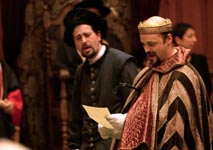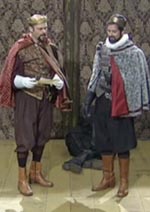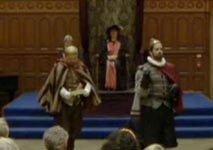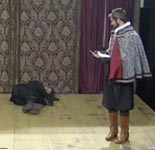- Edition: King Leir
King Leir
- Introduction
- Texts of this edition
- Contextual materials
- Facsimiles
43King Leir, Scene 5
Cast
Cornwall: Jason Gray
Cornwall's Servant: David Kynaston
Cambria: Scott Clarkson
Cambria's Servant: Phil Borg
Queen's Men Dramaturgy: Medley Style (Sc. 5)
44Read about the Queen's Men medley style in Scene 4
This key scene embodies the dramaturgy of the play as a whole. Cambria and Cornwall both play their parts in the shocking treatment of King Leir, but here they are introduced in a different mode. They each appear on stage accompanied by an exhausted and begrudging servant. They also both have riding crops and letters, and express their eagerness to reach their loves. Initially they don't notice each other and then they "start to see each other" (TLN 421) . The repetition and mirroring in addition to what is apparently a classic double-take are techniques of comic dramaturgy and only by embracing the implications of these techniques could we unlock the spirit of the scene and the characters at this point of the play. The rehearsal process, once again, involved breaking down our neoclassical division of the serious and the comic, and separating our work from assumptions arising from our knowledge of Shakespeare's tragedy.
45 The comic tone of the scene is confirmed by the central double-entendre on the words "whole" and "hole" (TLN 453-457). The joke constructs the characters as comedic lovers and reveals that sexual desire is as much their motivating force as it is for Gonorill and Ragan, a fact emphasized during the exchange between the sisters in the following scene, which quibbles comically on "nothing" (TLN 490-493).
Read more about Queen's Men medley style
Performing Cornwall and Cambria (Sc. 5)
46 Like the King of Gallia, Cambria and Cornwall enter the action as quasi-chivalric knights, here riding desperately to meet the objects of their desires. They are products of romance, not tragedy or history. The SQM actors gave their characters a level of naivety that allowed them to live through the surprises and coincidences of the scene without commenting ironically on them. The discovery of their shared purpose and the fact that they would soon be "brothers" (TLN 445) emerged with a sense of joyful wonder. The audience could thus laugh warmly at them rather than sneer with detached ridicule. The comic interpretation of their characters in this scene proved problematic for the SQM actors when working on the more serious side of their characters later in the play.
Read more about performing Cornwall and Cambria
The Comic Servants
47 The comic servants that accompany the knights are featured only in this scene. By playing up the servants' exhaustion we were able to establish a comic tone right from the outset, priming the audience for a light-hearted reception of the two kings. The servants entered behind their sprightly, eager princes and threw themselves in a heap on the floor, addressing themselves directly to the audience. Upon their masters' exits the two servants lumbered off after them reluctantly, maintaining audience interest until the stage was finally cleared for the opening of the next scene.
Watch video of Scene 5 on the Performing the Queen's Men website. (The video footage is password protected. Click on "Cancel" in the pop-up window to obtain password.)





